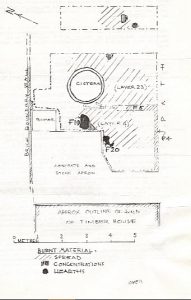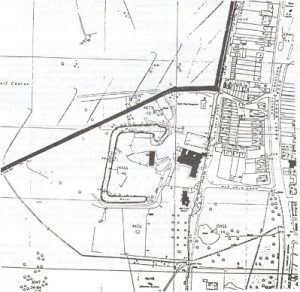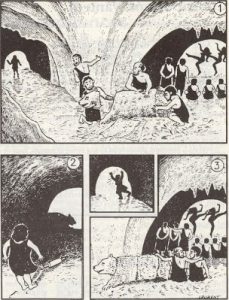Newsletter-261-December-1992
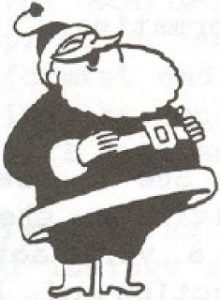
Tuesday 1st December Christmas Dinner at Fulham Palace. All places now booked with a short waiting list. But do ring (203 0950) if you would like to come – there may be last minute cancellations
January no meeting
Tuesday 2nd February Ancient Near East Cylinder seals by Dr Dominique Colton (British Museum). Cylinder seals were made in the Near East from c.3300 – 300BC and are a major source of information for the historian and dating tools for the archaeologist
Saturday 6 February (afternoon) Plans are being made for an EXHIBITION OF BROCKLEY HILL POTTERY at St Marys Church Hall, Hendon and a guided walk round St Mary’s Church and churchyard. More details later.
Tuesday 2 March EXCAVATING IN NORTHERN IRAQ: From the Greeks to the
Mongols by Dr John Curtis (postponed from November)
Tuesday 6 April EXCAVATIONS AT FULHAM PALACE by Keith Waterhouse.
ARCHAEOLOGICAL INVESTIGATION OF THE LINE OF THE A41 KINGS LANGLEY & BERKEAMPSTEAD BYPASS Lecture report by Ted Semmes
November 3rd attracted a good attendance to hear Clare Halpin, Assistant Director of the Herts Archaeological Trust talk of the work they had carried out on this relief road. This was a mammoth task archaeologically covering a road length of 19 kilometres. The line was mostly on high ground, south and above the line of the present A41. The construction of such a road involved the unit employing its own earth-moving equipment to obtain maximum flexibility. These monsters had been operated by Tom McDonald who was present and answered some of the questions.
Clare said that in the past it had been reckoned that an average of one site per 11/2 kilometres would be found and this was confirmed on this 19 kilometre dig! She gave helpful details on proceedure to enlighten us on techniques.
As well as the line of the road, it had been necessary to do strip sampling on the site where the top soil was to be piled (400,000 cubic metres!) Regrettably Clare did not produce any slides showing maps of the sites – but I will just report three features,
Above Kings Langley a site dating from the Neolithic to Bronze Age had been followed up, taking in eight new sites in all. The Neolithic at Rucklers Lane showed parallel ditches of a causewayed camp, enclosure or cursus – maybe this had ceremonial functions.
On a Bronze Age/Iron Age site four and six post hole structures had been detected and excavated together with small scoops in the soil interpreted as working areas. Grims Ditch, that archaeological enigma, had also been sectioned, but again with scant dating evidence.
Where the line of the road came down to the level of the Bulbourne Valley near Hemel Hempstead station, a peat deposit – rare for the south of England – was encountered.
An interesting talk which with the help of slides showing maps of the sites and some artefacts as well could have been more informative
NEWS OF MEMBERS
Mrs Frances (Mary) Gravatt is a member of long standing. She is now in her 80s and as she can no longer participate in our activities, she is resigning with some regret. In earlier years she was a very active member, assisting Brigid Grafton Green with the production of Blue Plaques of Barnet. She sends her regards to all who remember her. She has donated a copy of her booklet on The Dissenting Meeting House in Brent Street 1821 to Baptist Chapel, Finchley Lane 1886, which will be in our library for anyone who wished to read it.
Mrs Banham has sent a letter telling us that she went on holiday for a month, had an accident to her right hand and was away for three months. We miss her on our outings – and the huge tin of sweets she brings to pass round the coach!
Frieda Wilkinson is now coping quite well at home, although she is by no means mobile and has to use a wheelchair. She has the phone beside her and would always be glad to have a call from friends in the Society.
Jack Goldenfeld has been working for English Heritage, the Museum of London and Bucks County Museum Archaeology Unit. He has taken two post-Diploma courses, Archaeological Draftsmanship and Wetlands Archaeology. Jack has been elected as an affiliate of the Institute of Field Archaeology and is teaching (for details see Conferences and Courses)
Ann Saunders author of Art and Architecture of London reviewed last month, was mistakenly described as Honorary Fellow of University College, London. She is a full Fellow. Apologies, Ann.
George Ingram Following the sad news of the sudden death of George, several members attended his funeral at Golders Green Crematorium. Sheila Woodward shared the address with the vicar – they were happy words. Just what George would have liked. All will be sad a his passing. The collection made at the last lecture raised t35 for the Glaucoma Association, with which he was closely associated.
TRIBUTES TO GEORGE INGRAM
We are unlikely to forget George (Uncle George to some of us), for a very long time. He died suddenly, after a few days in Edgware General Hospital, on October 29th in his 92nd year.
I first remember George on the Church Terrace, Hendon dig in 1973. At that time he was dividing his activities between music, local history of Wimbish in Essex and the past of Hendon. He was deeply interested in anything, however slightly out of the ordinary and in later years persuaded his family and HADAS members to stop whilst his camera came out to record whatever had caught his eye. With this in mind he quickly took to the task of recording the inscriptions on the gravestones in St Marys churchyard, Hendon. Indeed, he once lamented to me that he came into this “archaeology/local history racket” too late in his life. On the abortive dig behind the Town Hall, Hendon we gave him the honour of ‘cutting the first sod’
George started the first HADAS book-box under Brigid Grafton Green’s inspiration and worked for some years collecting details of Non-Conformist and other religious places of worship in the Borough. On all outings he would always turn up with a pocket full of Murray Mints. Yes, he will be missed. Ted Sammes
George Ingram’s death was sudden and unexpected. At 93, he had had a good innings and I think there is always a sense of relief, once the shock is over, that a good friend has passed with little pain and discomfort.
I had so much fun with George. Some HADAS members take life rather seriously and are positively po-faced when it comes to a dig. Who can forget George’s assertion that West Heath (in spite of all the evidence) was merely a site that had top soil containing flints dumped on it sometime in the past. Or my own small dig in Cedars Close where George insisted that I had got it all wrong and was only slightly embarrased when I mentioned his remarkable theory in my report. When I questioned him about why he always expressed a minority view, he said it was all to do with his work which was concerned with auditing accounts. He was paid to spot mistakes and he couldn’t get out of the habit!
But I shall always remember George selling books at the ]inimart – a bottom–less pocket full of Murray Mints and a smile for everyone. His incredible eye for detail and the carefulness of his records, with filing systems to match, are other aspects of his character which will be treasured in memory. So will his famous photographs, terrible compositions but captions that would be difficult to better.
There were sveral HADAS members at Golders Green Crematorium to say their last farewells to George. It was a moving and delightfully simple ceremony with good music. A fitting finale to a very nice man. Percy Reboul
George’s daughter, Ruth Dean, has written to all HADAS members would like to take this opportunity, on behalf of myself and my family, to thank you all for the generous donation collected for the Glaucoma Association in memory of my father.
I know he will he sadly missed by friends and aquaintances alike, but most of all by myself and my family. As Dorothy said, be always kept cheerful and tried tq help anybody in difficulty. He had a long and varied life, as 1 am beginning to find out, more and more, whilst going through his numerous papers.
I know be enjoyed his time with HADAS (all twenty years), which included many outings and coach trips and when he was younger he loved to participate in digs.
So thankyou HADAS for being friendly to my Dad and keeping him occupied, as I am sure you helped him to have a longer life.”
REPORT ON FIELDWORK IN EDGWAREBURY PARK by Brian Wrigley
As was reported by Bill Bass in Newsletter No 254 of May 1992, NADAS assisted with some fieldwork for the Museum of London Archaeological Service’s archaeological assessment of Edgwarebury Park north section before tree planting for the Community Forest Programme. MOLAS’s report was made in March 1992, recommending that ground preparation should be by individual holes instead of ripping as originally proposed, and that there should be an archaeological Watching Brief on the work.
We heard no more for some time, and of course thought that English Heritage, MOLAS, the Forestry Commission and London Borough of Barnet were discussing arrangements, of which we thought we should hear in good time if our help was needed. In the event,
it was only at the beginning of October that we heard from LBB Parks Contracts Manager, James Rea, that it had been agreed that holes should be dug, with archaeological observation. On 1 October (Thursday) Mr Rea telephoned to tell me that auguring the holes would begin the next Monday, and could HADAS provide the archaeological watch.
This left little time for arrangements, but fortunately Myfanwy Stewart, Bill Bass and myself were able between us to cover the work, lasting the week of 5 to 9 October, on which we now report.
SCHEME OF WORK
The work was not actual planting, but machine augering of holes to break up the soil; they were 30cm diameter, 30-40cm deep, set at app 2 metre intervals in rows app 2 metres apart. Planting areas are shown hatched on the attached plan, and we estimate there were about 1800 holes. The holes had to be backfilled after each day’s work, and indeed a large part of the loose spoil from the auger was left in each hole so that any finds in it could only be regarded as stray surface finds. We therefore concentrated on the side
and bottom of each hole to look for any reliable indicators in undisturbed soil or sub-soil.
OBSERVATIONS
We were able to establish that over the whole area, the holes reached the solid natural underlying yellowish clay, showing a layer of organic soil above it varying in depth from app 10cm to 30cm; the thicker soil was mainly in the lower-lying ground, with a thinner (no doubt eroded) layer in the higher ground which is the southern part of the planting area. We noted that some holes were drier, with light brownish powdery spoil compared
with other darker, stickier spoil in surrounding holes. As more holes were dug, however, we were able to see the linear NW-SE pattern of these drier holes and to relate it to the pattern of NW-SE field drains noted in our survey in February.
In the areas marked C and D on the plan the spoil was generally drier (on higher ground) but there were two holes which showed up noticeably black and moist against the surrounding lighter drier holes: these were in the areas marked on the plan as X and Y (we had no opportunity to measure them in). They could conceivably indicate pits or a ditch, or they may be the traces of former trees. There was no artefactual evidence to help.
We noticed a number of frost-fractured flint lumps, which appeared to concentrate in the higher area (B on plan); from one or two instances of flint lumps firmly bedded within the natural clay, we concluded there is a band of naturally-occurring flint in this area.
CONCLUSIONS
The findings are the same as for most of the Three Valleys water pipeline excavation a little to the north in this same area, which was observed in 1990 – no evidence of any manmade disturbance of natural London clay below the shallow turf soil. The large number and closeness of the holes over a considerable area indicates this as pretty reliable negative evidence well worth the effort of gathering.
FINDS
2 struck flint flakes, 1 of Mesolithic type
1 medieval body sherd
Sundry post-medieval, Victorian, and modern pottery sherds
Some fragments of post-medieval, Victorian, and modern drainpipe.
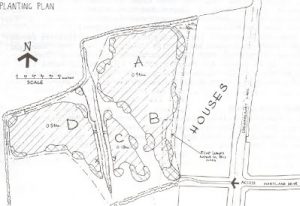
FURTHER WORK
It is understood that actual planting will be in later November this year; if there is opportunity for further observation, we recommend special attention be paid to the areas of the ‘black holes’, at X and Y.
ACKNOWLEDGMENTS
We would like to thank Mr James Rea of the London Borough of Barnet for ensuring that we had this opportunity, and Mr Richard Lomax and his team from Fountain Forestry for their help and
co-operation on site.
I add my personal thanks to Myfanwy Stewart and Bill Bass for standing in at such short notice.
COURSES AND CONFERENCES
Archaeology in Britain ’93 7th annual conference of the Institute of Field Archaeologists will be held at University of Bradford 6-8 April 1993. Open to everyone (i.e. not restricted to members of I.F,A.)
Basic Archaeology Three-term adult education course at Ricknansworth School for West Herts College, taught by HADAS member, Jack Goldenfeld. New course Supply and Demand in Antiquity – the archaeology of trade and exchange starts week beginning 11 Jan. at Elm Park College, Stanmore, Phone Jack for details on 0923 285225.
Sumner Academy Week-long courses hosted by nine universities, June September 1993. Subjects offered include: Hadrian’s Wall and the Roman Army 3-10 July at Durham; Roman Scotland 10-17 July at Stirling; Chester: Walled City Through the Ages 17-24 July at Chester; Life in Ancient Egypt 17-24 July at Canterbury; Roman France 24-31 July at Canterbury; Iforwich; a Historic City 7-14 August at Norwich; Celtic. Wessex and its Hillforts 14-21 August at Southampton. Prices: £260 £320. For brochure phone 0227 470402 (24 hour service).
NEWS FROM OUR NEIGHBOURS
Barnet & District Local History Society HADAS member John Heathfield will be giving a talk “`umble ‘adley” at 2.30pm on Monday 7 December at Barnet Museum, Wood Street. Admission by ticket only – available from the Museum (081-440 8066).
The Historical Association – Hampstead and N V London Branch invite all HADAS members to an illustrated lecture by T.G.H. James (formerly of B.M.) Howard Carter Before Tutankhamen on 21 January at 8pm in Lower Skeel Hall, King’s College, Kidderpore Ave., NV3 (former Westfield College), Phone Joyce Wheatley on 081-455 2820 for further information.
CUTTING THROUGH A CONFUSION!
Ted Sammes comments on “Excavation News” (page 5 in last month’s Newsletter) –
“I must try to put Church End Hendon into its correct connotation: The word “church” comes into use five times at least at Hendon – 1. The Church; 2. Church House; 3. Church End Farm (HADAS’ first dig 1962-66); 4. Church Farm or Farmhouse (now Church Farmhouse Museum); 5. Church Terrace (now The Heritage, site of HADAS dig 1973-74).
Bill Bass can be excused for getting confused – even Nicholas Pevsner in his Buildings of England has muddled Church End Farm (now under part of Middlesex University) with Church Farmhouse, the Museum. There were no Roman finds at Church End Farm in 1960s; they came 10 years later with Saxon material at Church Terrace, opposite Church House and next to the “Clerk’s Cottage”. Sorry Bill! You’re not the only one who’s confused!”
HOT NEWS FROM HENDON from Andy Simpson
I was woken from my desk-bound slumbers at the RAF Museum recently (only kidding, Mr. Director, Sir!) by a visit from one of the Museum of London team who had just arrived for a two-week stay on part of the old RAF Hendon East Camp- that part of the site facing Grahame Park Way, between
the Officer’s Mess and RAF Museum’s large white “Battle of Britain” Hall. This will be the site of the new Colindale Police Station, whose construction necessitated a trial excavation by the Museum of London. Five trenches were cut by JCB to a depth of approx. 50cm, coming down onto natural London Clay. At the time of writing, on the day of a site visit by myself and Brian Wrigley, no archaeological features had been found othet than a large number of modern field drains and a handful of 17th century pottery and clay pipes.
The museum team had studied 18th century maps of the area and noted a couple of potentially interesting field boundaries. It was also thought that an early boundary ditch might be in the area.
This excavation is one of a number undertaken in the area recently by the Museum of London, including Edgwarebury and a pipeline across Hampstead Heath. The former yielded modern plough marks, the latter a Roman coin but nothing else of note.
The current pattern for the Museum seems to be a large number of small evaluation digs, rather than larger-scale excavations. The change in the type of work being prompted, at least in part, by the new planning regulations in PPG 16.
EXAMINATION OF EXCAVATION FOR EXTENSION OF THE GARDEN HOSPITAL, 46-50 SUNNY GARDENS ROAD, 1.W.4 in October 1992 Report by Percy Reboul
The location of a modern, private hospital in a quiet backroad of Hendon is something of a surprise. The Garden Hospital at the junction of Rowsley Avenue with Sunny Gardens Road had a bad reputation with local residents when it opened 30 years or so ago. Since that time, however, it has become internationally famous for its pioneering approach to natural childbirth and offers a full range od surgical, medical, X-ray, physiotherapy and pharmacy and other facilities for both out-patients and in-patients. The expansion of the hospital reflects its increasing success and good reputation.
HADAS’ interest concerns an area being excavated to accommodate a new extension. The original site was occupied by a nursing home and semidetached Victorian villas, some of which were demolished to make way for the original hospital building and some of which were re-faced and extensively altered within to accommodate part of the hospital. The new development called for the demolition of these remaining Victorian houses and their replacement by a new building.
The area of excavation was 18m x llm 3.5m deep with further depth in parts to accommodate passenger lift shafts. This was carried out by a large JCB on week commencing 12 October 1992. No evidence of any kind was found during the excavation of the pit but the sheer volume of the spoil thrown up by the machine made detailed examination almost impossible. Nothing of archaeological significance appeared in the baulks and perhaps the only surprise was the sudden transition from top soil (50cm) to heavy, natural clay.
It will be remembered that HADAS interest in this location stems entirely from the Roman cinerary urn found near to the site which contained the ashes and calcified bones of a youth. No other evidence of Roman occupation has ever been found. Am I the first to postulate that the original find may have been a hoax?
A photographic record was taken of the roof timbers of the Victorian houses with a further series of the new excavation, showing among other
things, the concrete underpinning of the foundations of the adjacent building. We were particularly indebted to Mr Clive Grantham of Alfed McAlpine, Mrs Gill Tripp of the Garden Hospital, building surveyer Derek Maynard Maynard and Robert Whytehead of English Heritage for their interest and co-operation.
LAUNCH OF FRIENDS OF CHURCH FARMHOUSE MUSEUM Report by Ted Sammes
Forty four people were present at Church House on 21 October for the launch of this new initiative. Martyn Kempson, Controller of Libraries Arts and Museums gave a welcoming introduction and was followed by two speakers with experience of the work of “Friends” elsewhere.
Mike Tagg from the RAF Museum said that although the museum had a staff of 790 there were still useful things that Friends could do to help. He also mentioned some areas where offers of help might not be welcome! Barry Green, Chairman of Friends of Whitehall, Cheam, Surrey told us what had been achieved from scratch for the 16th century Tudor house. They manage to raise £1000 a year – enough for the museum to survive for 12 months if other sources of funding failed. Council help was vital to their success. Whitehall Friends had achieved charity status and members receive four newsletter a year.
Possibly the most cheering aspect of the evening was that the meeting had been called and coupled with an assurance that admission charges to Church Farmhouse Museum would not be made.
Ten people volunteered to form a Steering Committee to prepare a Constitution for The Friends of Church Farmhouse Museum as well as recommendations for subscription rates and proposals for activities and areas of support for the museum.
It is hoped to hold the Inaugural meeting of The Friends of Church Farmhouse Museum early in the New Year and details will appear in this Newsletter. If you would like more details please phone 081-368 1255 ext.3153 to speak to me – wearing my Libraries Development hat. Editor.
TWO BOOKS FOR CHRISTMAS
A new fully illustrated 90- page book about the History of Totteridge has just been produced. It is available from the author, Dr Diana Griffith, 27 Southway, N.20 price £8.50 plus £1.30 post and packing.
A splendid selection of 183 pictures from the Libraries’ Local Studies collection are reproduced in Finchley and Friern Barnet published by Phillimore, price £11.95. The authors, Pamela Taylor (Archivist) and Stewart Gillies (Local History Librarian) are well known to many HADAS members. Copies available from your local library.
THE COUNTY OF MIDDLESEX TRUST was founded in 1990 to make people aware that the geographical County of Middlesex still exists. Its aims include the preservation of historic buildings and all other aspects of the County’s history & heritage. Details from Secretary, 36 Warden Ave., Rayners Lane, Harrow, MIDDLESEX, HA2 9LW (Subs. £5 minimum
)

